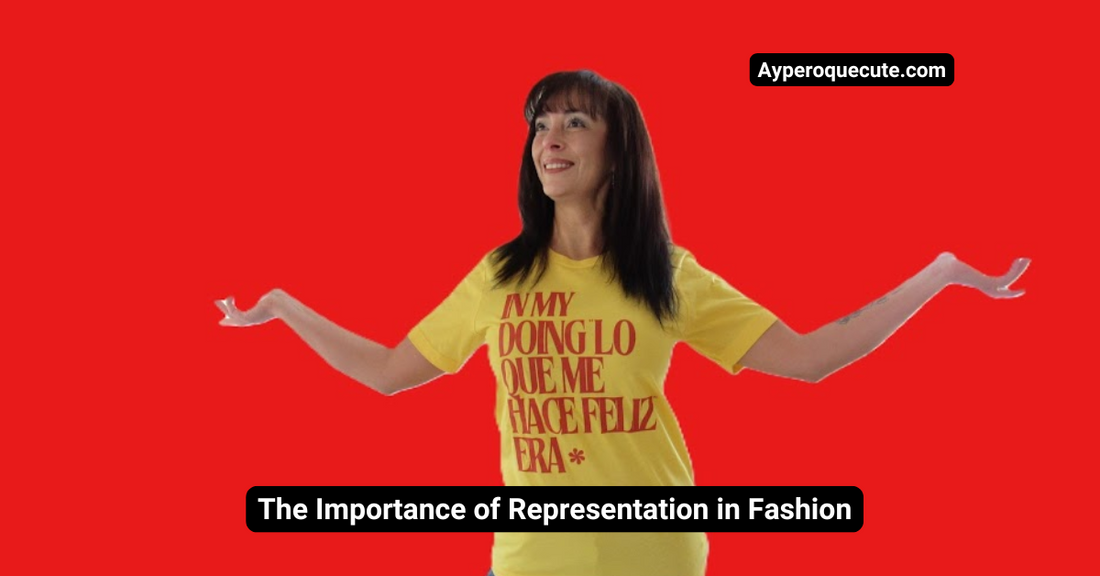
The Importance of Representation in Fashion | Ay Pero Qué Cute’s Perspective
Share
Fashion is more than just clothing, it is a powerful medium of self-expression and cultural identity. However, for decades, the fashion industry has been dominated by a narrow and exclusive beauty standard, leaving entire communities unseen and unrepresented. From high-fashion runways to mainstream retail stores, representation has often been limited to a select group that does not reflect the diverse world we live in.
Historically, fashion has favored Eurocentric beauty ideals, thin, tall, and predominantly white models were positioned as the standard of beauty. This lack of diversity has shaped industry norms, excluding people of different races, body types, genders, and abilities from the conversation. The consequences of this exclusivity go beyond aesthetics; it impacts how individuals see themselves and their place in society.
At Ay Pero Qué Cute, we believe representation in fashion is not just a trend, it is a necessity. Our brand is committed to creating fashion that celebrates culture, individuality, and inclusivity. By designing apparel that reflects diverse identities and backgrounds, we aim to redefine fashion as a space where everyone is seen, valued, and empowered.
Read Also: Traditional Mexican Outfits: History, Styles, and Cultural Significance
The Impact of Fashion on Identity and Self-Expression
Fashion is a reflection of who we are. It allows individuals to express their culture, personality, and values. However, when people do not see themselves represented in fashion, it can have a profound effect on self-esteem and confidence.
Why Representation Matters in Fashion:
-
It Validates Identity: Seeing models, designers, and fashion leaders who share your background fosters a sense of belonging. Representation reassures individuals that their identity is acknowledged and celebrated.
-
It Encourages Confidence: When diverse body types, skin tones, and cultural influences are represented in fashion, it empowers individuals to embrace their own uniqueness.
-
It Preserves Cultural Heritage: Inclusive fashion recognizes the significance of different traditions, fabrics, and styles that have shaped global fashion trends.
The Negative Impact of Exclusion:
-
Creates Unrealistic Beauty Standards: The dominance of one body type or look can make individuals feel pressured to conform, leading to unhealthy beauty expectations.
-
Leads to Self-Esteem Issues: When people do not see themselves reflected in fashion, it can lead to feelings of inadequacy and lower self-worth.
-
Marginalizes Communities: A lack of diversity in fashion reinforces social exclusion, making it harder for underrepresented groups to feel valued in mainstream culture.
Representation in fashion is not just about aesthetics; it is about shaping a society where all individuals feel included and empowered.
The Shift Towards Inclusive Fashion
-
Growing demand for inclusivity, driven by:
-
Social media activism challenges traditional beauty standards.
-
Consumer awareness pushes brands to be more representative.
-
Rise of independent brands embracing diversity.
-
Major brands have responded by:
-
Expanding size ranges to be more body-inclusive.
-
Featuring diverse models across different races, genders, and abilities.
-
Launching gender-neutral collections to break rigid fashion norms.
-
Challenges that still remain:
-
Luxury fashion still lacks diverse representation.
-
High-fashion runways continue to favor Eurocentric ideals.
-
Performative inclusivity, where brands use diversity for marketing but lack real change.
Diversity vs. True Inclusivity: The Difference That Matters
Many fashion brands today highlight diversity in their campaigns by featuring models of different races, body types, and genders. While this is a positive step, it does not necessarily mean the brand is truly inclusive. Diversity is about visibility, but inclusivity is about equal participation at every level of the industry.
True inclusivity in fashion means:
-
Representation in leadership: It is not enough to have diverse models on the runway. True inclusivity happens when people from different backgrounds hold positions as designers, executives, and creative directors.
-
Equal opportunities behind the scenes: The people who shape fashion photographers, makeup artists, and stylists should reflect the diversity seen in campaigns.
-
Cultural appreciation, not appropriation: Brands should collaborate with communities to respectfully incorporate cultural influences rather than using them for profit without understanding their significance.
-
Beyond marketing: Some brands use diversity as a marketing tool but do not make real changes in hiring practices, product offerings, or leadership representation. This type of “performative inclusivity” does not create lasting impact.
For fashion to be truly inclusive, representation must exist at every level, not just in advertisements but in the decision-making process that shapes the industry.
Ay Pero Qué Cute’s Approach to Inclusive Fashion

At Ay Pero Qué Cute, inclusivity is not just an afterthought, it is the foundation of our brand. We were created with a mission to celebrate Latina culture and diversity through fashion that is bold, expressive, and empowering.
Our designs are inspired by real people, real stories, and real heritage. We don’t just follow trends; we create fashion that represents our community. Whether through vibrant colors, culturally inspired graphics, or empowering messages, our clothing is designed to make people feel seen and valued.
We prioritize inclusivity in every aspect of our brand by:
-
Authentic representation in campaigns: Our models reflect the diverse backgrounds of our customers, ensuring that people of all races, sizes, and identities can see themselves in our brand.
-
Collaborations with diverse creatives: We partner with designers, photographers, and influencers from different backgrounds to ensure a wide range of voices are part of our creative process.
-
Clothing that embraces all body types and identities: Fashion should be accessible and flattering for everyone. Our designs are made to be worn with confidence, no matter your shape, size, or style.
For us, representation is not a marketing strategy, it is a responsibility. We believe in making real change by ensuring that everyone, especially those who have been underrepresented in fashion, feel included and celebrated.
The Role of Sustainable and Ethical Fashion in Representation
True inclusivity is not just about who wears the clothes, it’s also about who makes them. The fashion industry has a responsibility to ensure that the people behind the scenes, from garment workers to suppliers, are treated fairly and ethically.
Why ethical production matters in representation:
-
Fair wages and safe working conditions: Many fashion workers, particularly in marginalized communities, are underpaid and work in unsafe conditions. Ethical production means ensuring fair treatment for all workers.
-
Sustainable fashion supports diversity: When brands prioritize sustainability, they support communities that are most affected by environmental issues, including coastal and indigenous communities.
-
Reducing fashion waste: Overproduction and waste harm both the planet and the workers involved. Brands committed to sustainability use eco-friendly materials and responsible production methods.
A truly inclusive fashion industry must consider not only who is being represented in front of the camera but also who is impacted by the industry’s practices behind the scenes. At Ay Pero Qué Cute, we are committed to ethical sourcing, fair wages, and sustainable production because real representation means creating a better fashion world for everyone.
Consumer Influence: How You Can Support Inclusive Fashion?
Consumers have the power to drive change in the fashion industry. By making conscious choices, you can support brands that truly value diversity, inclusivity, and ethical practices. Here’s how you can contribute:
-
Shop from brands that prioritize diversity in marketing and leadership: Support companies that not only feature diverse models but also have inclusive hiring practices and diverse leadership teams.
-
Look for brands that support sustainable and ethical fashion practices: True inclusivity extends to fair wages, ethical sourcing, and environmentally responsible production.
-
Engage with and amplify diverse voices in the fashion industry: Follow and promote designers, models, and influencers from underrepresented communities. Visibility matters.
-
Hold brands accountable for performative inclusivity: Research whether a brand’s commitment to diversity goes beyond marketing campaigns. Demand transparency in hiring, wages, and company culture.
-
Use social media to support brands that authentically represent various communities: Follow, share, and engage with brands that are making a real difference in representation. Consumer demand shapes industry trends, and your support sends a powerful message.
Conclusion
The fashion industry has made progress in embracing diversity, but true representation is an ongoing movement. While more brands are recognizing the importance of inclusivity, there is still work to be done to ensure that all communities are genuinely represented, not just in marketing but in leadership and decision-making roles.
Consumers play a crucial role in shaping the future of fashion. By choosing to support brands that prioritize inclusivity and ethical practices, individuals can push the industry toward meaningful change. Representation should not be treated as a trend but as a permanent shift in how fashion operates.
At Ay Pero Qué Cute, we remain committed to being a brand that reflects real people, real culture, and real empowerment. Our mission is to celebrate diversity in fashion by creating designs that allow individuals to express themselves authentically.
FAQs
Q. Why is representation important in fashion?
Representation in fashion ensures that people of all backgrounds, body types, and identities feel seen and valued. It helps break stereotypes, promotes inclusivity, and allows individuals to find clothing that resonates with their cultural and personal identity.
Q. How does fashion represent a person?
Fashion reflects an individual's personality, culture, and values. The way people dress can express their confidence, creativity, beliefs, and social identity, making it a powerful tool for self-expression.
Q. Do clothes represent people's culture?
Yes, clothing is deeply connected to culture. Traditional garments, patterns, and fabrics often carry historical and cultural significance, preserving heritage and identity across generations.
Q. Can fashion describe your personality?
Absolutely. Fashion choices, whether bold, minimalist, colorful, or edgy, can showcase different aspects of a person’s personality, giving insight into their tastes, lifestyle, and even mood.
Q. How does clothing represent identity?
Clothing is a form of identity expression, allowing individuals to showcase their background, beliefs, and affiliations. It helps people feel a sense of belonging while also distinguishing their unique personal style.
